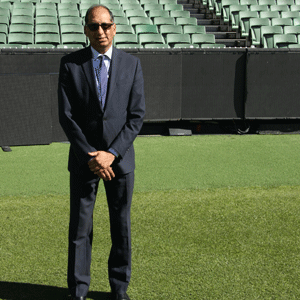THANK YOU FOR SUBSCRIBING

Renato Reis, CIO, Orlando City SC
What I hear most often when discussing sports business strategy is that the biggest asset of a sports organization is on the field. Well, as important as star players and championship hardware are to drive the business toward success and profitability, I would counter that fans are the organization’s biggest asset. Furthermore, better understanding them–their likes and dislikes, behaviors, purchasing trends, and other psychographic and demographic details–is the way to disrupt and expand beyond the traditional sources of revenue.
Like other sports, soccer relies on a business model that maximizes the event–tickets, suites, broadcast revenue and sponsors–a source of revenue with limited inventory. Take Orlando City Soccer Club (OCSC) as an example, a young soccer organization that has been successful enough to have sold out 18,000 season tickets well before the season starts and grown a sizeable portfolio of blue-chip corporate partners. But to reach beyond predictable economics, sports organizations have to equip themselves with tools to improve operations and enable an omnichannel engagement with fans. The ability to collect, centralize, and analyze all the available structured and unstructured data from all different touch points is critical. A club can then tailor targeted messages and move from transactional marketing to relationship marketing, incorporating the learning into a Fan Relationship Management (FRM) system capable to provide a single source of factual data and a true 360० view of fans and their interests.
The challenge for IT executives commissioned to bring this transformation to sports organizations lies in two areas. First, solution providers still perceive sports organizations as small accounts and do not offer competitive enterprise-level deals, despite the fact that the sports industry generates over $60 billion a year in North America alone. Their focus is still in the number of potential back-office user licenses. They are missing the potential of fan communities, data analytics, and the marketing value of having a success story associated with a brand that so many people are passionate about it, and in many cases are potential consumers. Second, is the long-held misunderstanding by some sports executives of the business benefits from the investment required to build a game changer digital strategy to, not just streamline operations or have another app, but to develop solutions to deep understand consumers and have the necessary intel to drive the strategic decision-making process.
“As a sports industry IT executive, you have to run a lean but mean IT machine”
As a sports industry IT executive, you have to run a lean but mean IT machine. Be strategic in your infrastructure and platform selection, as well as when planning your headcount budget and skill selection. Think hard when it comes to on-premises vs cloud solutions, and who can offer you the peace of mind when it comes to security and scalability. Be mindful that during the peak period of your events, such as a Super Bowl, a Champions League final, a Barça vs Real Madrid, or any event that packs the arena or stadium, you will need “elasticity” to support and extract the most of the potential data generated. For example, the Seattle Sounders moves 5.5 TB of data through their WiFi during a match. The backbone of your system’s infrastructure should guarantee not just your performance and security expectations, but the reliability when it comes to bringing all data together to generate that killer analysis. Your dev platform should be easy to integrate, rapid to develop and device agnostic.
The goal to provide the best experience to fans and understanding their needs without losing focus of the business goals is becoming a top priority for all modern and competitive sports organizations. Manchester City hired Goodform, a CRM consultancy, to help implement their CRM to promote accurate and contextual information across the organization as part of City’s plan to become the most popular soccer club in the world. The Orlando Magic uses SAS to improve the fan experience by analyzing purchasing history, including sales at concession stands and team stores. It applies analytics to the data to compile a big-picture view of all customer activity. The Magic has also partnered with VenueNext, the tech firm founded by the San Francisco 49ers, to develop an all-inclusive mobile application at the Amway Center, creating a seamless experience for their fans. The Boston Red Sox have also adopted an aggressive CRM strategy using Green Beacon. Other examples include FC Bayern Munich & SAP and Real Madrid & Microsoft partnerships. We can go on and on with a list of success stories about great sports organizations moving toward a level of high tech sophistication that was, not so long ago, a prohibited conversation among decision-makers.
As a young but dynamic organization, Orlando City SC will take advantage of these case studies and learn from these success stories. We will make use of one of the most powerful and reliable cloud platforms currently available in the market, Salesforce.com, combined with Kore Software’s ticketing solution. OCSC needs to have the flexibility to constantly change and adapt its services by listening to our fans’ opinions and suggestions. We want to understand what is important to our fans, what shapes their universe, and design our outreach programs based on that information. We will be prepared for a hyper connected fan community with e-social expectation beyond today's standards.
Traditionally, sports teams haven't seen the need to invest in high tech strategy and products to make sense of their fan data. It is understandable that the core of the investment will be in their on-field product. The common perception is that if the team wins, the fans will come. History has shown that this is not always the case, and it creates a huge opportunity for systems and qualified professionals to help improve operations and influence the bottom line.
Of course, success on the field and big names on the roster will drive interest to the Club's brand, but it is the understanding of fans’ aspirations, emotional ties, and the sense of belonging that will drive the loyalty and make them proudly display crest magnets on their cars. This is key to help sell that last lot of tickets or jerseys that will make the difference in your financial landscape, but to achieve that you need a digital strategy where you can capture, share, slice and dice your data, and learn what is important to your most important stakeholder, your fans.
Weekly Brief
I agree We use cookies on this website to enhance your user experience. By clicking any link on this page you are giving your consent for us to set cookies. More info
Read Also
Artificial Intelligence - Myths And Truths
Sustainable Future through Innovative Technology Solutions
The Future Relies on Augmented AI
Digitalization with the use of digital technologies/Improving business through digital technologies
How Marco's Pizza Leaned On Technology To Succeed Amid The Pandemic By Quickly Pivoting To Contact-Free Delivery And Curbside Carryout
Bunnings Diy Digital Transformation
For a Smarter City: Trust the Data, Ignore the Hype
Smart Community Innovation for the Post Pandemic






















